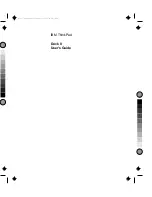
User’s Manual
Glossary-8
Glossary
floppy diskette drive (FDD):
An electromechanical device that reads and
writes to floppy diskettes.
floppy diskette:
A removable disk that stores magnetically encoded data.
Fn-esse:
A TOSHIBA utility that lets you assign functions to hot keys.
folder:
An icon in Windows used to store documents or other folders.
format:
The process of readying a blank disk for its first use. Formatting
establishes the structure of the disk that the operating system
expects before it writes files or programs onto the disk.
function keys:
The keys labeled
F1
through
F9
that tell the computer to
perform certain functions.
G
gigabyte (GB):
A unit of data storage equal to 1024 megabytes.
See also
megabyte.
graphics:
Drawings, pictures, or other images, such as charts or graphs,
to present information.
H
hard disk drive (HDD):
An electromechanical device that reads and writes
a hard disk.
See also
hard disk.
hard disk:
A storage device composed of a rigid platter or platters that can
be magnetically coded with data. Hard disks hold much more
information than diskettes and are used for long-term storage of
programs and data. The primary (or only) hard disk in a computer is
usually fixed, but some computers have secondary hard disks that
are removable. By default, the hard disk is referred to as drive C.
hardware:
The physical electronic and mechanical components of a
computer system: typically, the computer itself, external disk drives,
etc.
See also
software and firmware.
hertz:
A unit of wave frequency that equals one cycle per second.
host computer:
The computer that controls, regulates, and transmits
information to a device or another computer.
hot key:
The computer’s feature in which certain keys in combination with
the extended function key,
FN
, can be used to set system
parameters, such as speaker volume.
I
i.LINK (IEEE1394):
This port enables high-speed data transfer directly
from external devices such as digital video cameras.










































